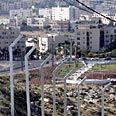
East J'lem neighborhoods
Photo: Haim Zach
Two weeks ago a young journalist, Daniel Ofir, reported a story on "Hot News" that ought to have created quite a storm: The Palestinian Authority is paving a highway inside Israel's sovereign territory in "united" Jerusalem, our eternal capital. The highway begins in the Atarot area and passes through the Kafr Akab neighborhood in Jerusalem along 2.6 kilometers inside the sovereign territory of united Jerusalem, and ends in Ramallah. What's more, the construction of the highway is primarily being built by the American Administration, which according to reports invested some $1.7 million in the project.
You haven't heard of this? Strange, after all it is a main road, with two lanes running in each direction: Work has been underway for three months already. The reason you haven't heard or seen anything (and even the majority of Jerusalem residents haven't heard of the project) is clear: The Palestinian neighborhoods in Jerusalem were never an integral part of the city, and the vast majority of the city's Jewish residents never stepped foot in Jerusalem neighborhoods such as: Abu Dis, Suwahara, Kafr Akab, Jabel Mukaber or Ras Hamis.
Compromise
Yedioth Ahronoth and Dahaf Institute survey reveals 52% of Israeli Jews willing to change Jerusalem's status as part of a permanent peace agreement with Palestinians, but 61% believe Israel should remain city's sovereign
The Egged bus company's public transportation routes in Jerusalem never reached the city's Arab neighborhoods, because there was no real need – the populations almost never mix anyway, and Jerusalem's Jews have no reason to visit the Arab neighborhoods.
Officially the Israeli government is continuing to stick to its slogan of a "united Jerusalem." All 250,000 Palestinians in Jerusalem are entitled to Israeli citizenship, but if they decline, they are automatically considered permanent residents (albeit without the right to vote in Israel's Knesset and without an Israeli passport, but with full social benefits such as health and education). The municipality is still obliged to provide full services to the eastern part of the city and even to parts situated outside the separation fence that Israel constructed.
Yet it is currently clear to all that there is no real intention, except for declarations of a "united Jerusalem," to continue holding onto these neighborhoods. The Israeli government has in actual fact already divided Jerusalem. The road currently being constructed by the Palestinian Authority with American aid is evidence that in practice Israel has no control over parts of eastern Jerusalem.
It is a road that was destroyed during Operation Defensive Shield in March 2002. Since then the Jerusalem municipality hasn't found it appropriate to repair one of the main and central roads situated inside its municipal jurisdiction.
For years the Palestinian Authority has been asking to carry out the works itself but Israel did permit it to do so. Apparently, only American pressure has now enabled the project to get underway despite government declarations.
Time to reach final status agreement
Hence, Haim Ramon's and the prime minister's PR advisors' statements regarding the relinquishment of Palestinian neighborhoods in Jerusalem actually verify a situation that has existed for many years.And so a Jerusalem solution is not as complex as it may seem. The separation between the two populations exists anyway, and all that remains is to finally sit down with the Palestinians and hammer out a final status agreement, to delineate the border that is known to all which divides between the Jewish and Palestinian neighborhoods and to sign an agreement that would end the occupation and the conflict once and for all.
A solution is possible. Continued declarations of a "united Jerusalem" are just empty slogans in a de facto divided Jerusalem. It's time to remove the mask and to act according to real Israeli interests: Namely, to reach a final status agreement that would allow the Palestinians to found a state alongside Israel with its capital in East Jerusalem.















